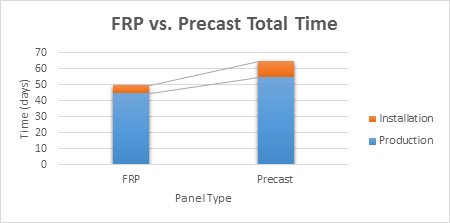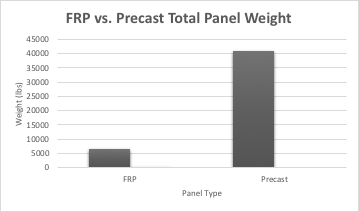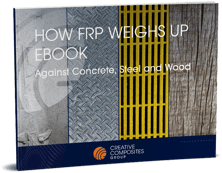When selecting a building material for an infrastructure project, there are a few key factors to consider before making a decision. Engineers must be sure to make selections that will benefit both the people within their agency, who will be working with the material, as well as the project’s end users.
One such material is fiber-reinforced polymer (FRP), which can be hugely beneficial for both builders and users. Read more below to find out how this unique material can work for you.
1. Production and Installation Time
When developing the design for your overall infrastructure plan, it’s important to factor in the amount of time that will be needed not only for the whole project, but also for each step within the process. Obviously, saved time translates to saved costs, but you certainly don’t want to sacrifice quality for efficiency. FRP can provide an ideal balance, helping to save valuable production time while still providing the necessary quality, strength and durability. Below, compare the production and installation time of FRP to that of precast concrete:

As you can see from the chart, FRP’s total production time is 15 days less than that of precast concrete. This translates to more than two weeks’ worth of saved labor costs and overall downtime for infrastructure development. FRP also requires less total installation time than precast concrete — almost five days less, on average.
Thanks to this shorter installation time, engineers using FRP don’t have to complete their work solely during the workweek. Instead, they can opt to do installation work on the weekends, too, when there is less traffic congestion and end users will experience less inconvenience and fewer interruptions to their commutes.
2. Weight
Going hand-in-hand with a quicker installation time is FRP’s weight. FRP is known for being lightweight. In fact, it’s about eight times lighter than reinforced concrete — meaning FRP is also less labor-intensive to use and install, and requires less equipment. This material also requires less labor during removal processes. See below to compare the total weight of FRP to the total weight of precast concrete.
As you can see from the chart, FRP is significantly lighter than precast concrete, with an FRP panel weighing about 5,000 lb and a precast concrete panel weighing nearly 41,000 lb. Using a lighter material makes it easier on your workers, saves on labor costs and places less stress on the infrastructure. The lower the weight of the material being used, the less wear and tear the infrastructure will experience as a whole.

3. Corrosion and Maintenance
Offering high durability and strength, as well as reliable resistance to corrosion, FRP is long-lasting and mitigates the need for ongoing maintenance. The lack of frequent maintenance and repairs helps to save on expensive labor and material costs and also prevents inconvenience to end users, since repair downtime is minimized.
And, since FRP is long-lasting and resistant to corrosion, the long-term costs end up being less as well.
Though FRP does have a slightly higher price point per square foot at initial installation, the material allows for many benefits in terms of long-term cost savings. Because FRP causes less stress on the infrastructure and is more durable than other materials, it diminishes the need for costly repairs or reconstruction down the road. For example, bridges and platforms constructed from materials such as reinforced concrete, steel, or wood often fall apart 15 to 20 years after initial installation — requiring extremely expensive repairs or even a whole new investment to rebuild from scratch. FRP, however, is built to last and won’t experience corrosion over time like many other construction materials.
4. cost savings
FRP structures are highly reliable and low-maintenance, but they shouldn’t be considered maintenance-free. Repairs requiring field service will need to be performed on rare occasions. Performing yearly routine inspections (at minimum) will help ensure potential issues can be caught before they become a problem. If an issue has been identified and reported (ex. cracks, crazing, discoloration, excessive wear, etc.), a field service technician will be sent out to complete the repair.
As mentioned, structures made from steel, concrete and wood are prone to regular repair work, as well as those made with brick and tile – that’s also where FRP can come in. Fiberglass can be used for patch repairs on bridge decking and liners can be applied to culverts, pumps, storage tanks and pipes to protect less-resistant materials from future damage. FRP can even be used for wrapping bridge piers and columns.
Repairs made with FRP add up to long-term cost savings. Since the material is corrosion-resistant and has a much longer service life, it’s a great option to use when repairing and protecting existing structures. Take a look at our brief case study to learn more about how FRP repairs reduce costs.
5. design flexibility
FRP is ideal for any type of job that requires customization, as it is engineered to meet exact specifications. Regardless of complexity, engineers can create panels of all different sizes and shapes. This allows for aesthetic versatility, as there is a range of possible colors. It is also possible to add functional features to facilitate a smooth and easy installation process.
Learn More
FRP offers a wide range of unique benefits — short production and installation time, light weight, long-term cost savings, corrosion resistance, and superior longevity. An ideal material for use in almost any infrastructure project, FRP is very dynamic, making it the perfect choice for all types of infrastructure — including vehicle, pedestrian, and trail bridges, cantilever sidewalks, rail platforms, waterfront frameworks, storage tanks and pipes, stairs and handrails, and much more.
Creative Composites Group has extensive expertise in both FRP materials, installation, and field services, and we’re a proud FRP manufacturer. To learn more about how FRP compares to competing materials such as reinforced concrete, steel and wood, download our eBook today.



